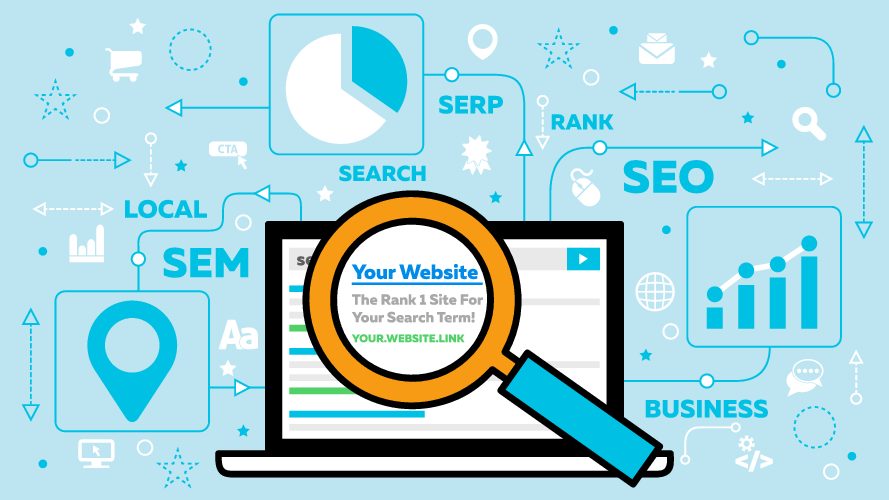Search engine optimization (SEO) — The process of affecting the visibility of a website or a web page in a search engine’s unpaid, organic results with keywords and/or keyphrases. The following is a short list of best practices to follow in managing your site’s SEO.
SEO On-page Optimization
Conduct basic keyword research, relevant to your website’s content, targeted to the visitors you want to attract. Tools such as Google Adwords Keywords Planner and Google Trends are a good place to start.
Pro Tip! Great SEO is achieved when traffic comes from people who search on thousands of terms. Often, it’s easy to think that everyone searches on the same terms, but the data shows otherwise. There are 100s of ways to express the same idea. Ranking in the search results for many terms is the sure path to success.
Best practice is to assign one primary keyword to each page to avoid cannibalization. Starting with your top pages (Home page, area pages, development pages, etc), incorporate your primary keyword in your page URL, Title, Description, header H1-Tag, H2s, and HTML body content, if it reads naturally, in the first sentence.
Web pages should be action-oriented and include specific CTAs (calls to action). If within three seconds a visitor can’t understand what information they are gathering, or next steps, they will leave the page without action. Show them value and clear next steps to take on the site with internal links to relevant pages.
Search engines don’t “see” images, so make sure your images are named in a meaningful way (i.e. not image123.jpg) and that images within the body of a page contain Alt-Text. While it’s good if your primary keyword works within an image’s Alt-Text, it’s best practice that this text describe what the image is if someone couldn’t see it.
Metadata
Title Tags (or Page Titles in our platform) are the HTML element that specifies the title of a web page. Title tags are displayed on search engine results pages (SERPs) as the clickable headline. Best practice is to include your primary keyword in the title tag and to keep title tags under 60 characters long. Recommended format for page title tags: [“Name” – “Category” | “Brand Name”] or [Jane Doe – Realtor | Brand Real Estate].
Meta Descriptions are the short line of text placed in the HTML of a web page that describes its content. The meta description sometimes appears under your page’s URL in search results. Meta Descriptions can be any length, but search engines generally truncate anything longer than 160 characters. It’s best practice to incorporate your primary keyword and keep meta descriptions between 150 and 160 characters.
Meta Keywords ceased to impact rankings in 2009 with Google. Bing may still use them, but only as a spam signal. In other words, too many irrelevant keywords in this attribute may actually harm rankings in Bing. Best practice is to assign the one primary page keyword in this field in the backend of your site.
Internal Linking
One of the ways search engines figure out what a page is about is by looking at the text in links that lead to the page. These links are found in your navigational menus, and in hyperlink text. You always want your links to read naturally while ideally including some of your target keywords. For example, you could have a page about the Boston Real Estate Market and this might be one of your search terms. If the link to this page reads “Boston Housing Market” instead of your target term, you’re missing out on an opportunity to reinforce the SEO you want.
Pro Tip! Don’t get carried away. A few links per page is fine. Hundreds will look like SPAM to the search engines.
Inbound Linking
More impactful but far harder to generate than internal links are links from other websites or inbound links. Some of the same rules apply. What’s most important about external links is what site they are on. Search engines rank websites by authority. For example, major universities are considered an authority. Whitehouse.gov is considered an authority. Web sites that have thousands of unique, fresh pages of great content, and have been around for decades have the most authority. A brand new website with almost no content that’s full of outbound links, by contracts, has no authority. You want links from the best websites on the internet to yours.
Pro Tip! The best inbound links come organically. If you create great content, other websites will link to you as the authority much more than you ever thought. Then, the search engines will take notice and, over time, your rankings will improve!
Keep your site current with great content
SEO is a never-ending campaign. The fodder of that campaign is quality content. If you create a great website and never update it, your content will become stale and your rankings will fall. Content comes in many forms. Text, infographics, video, audio, photos, blogs, development profiles, area profiles, and much more.
Pro Tip! Keep your main keywords consistent in the header, title of the page, URL, body, and meta description.
Need help with your 2017 SEO strategy? Like the ideas mentioned in this post but don’t know how to implement them? Our digital marketing team has you covered. Click here to learn more.
